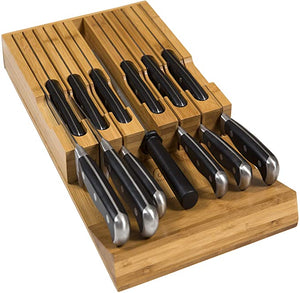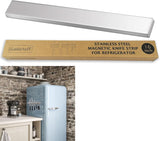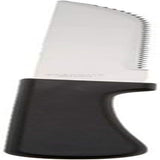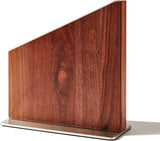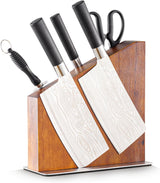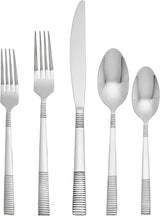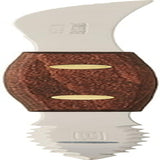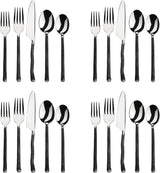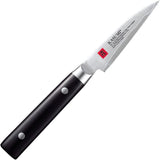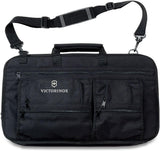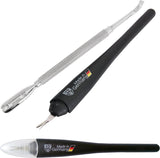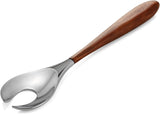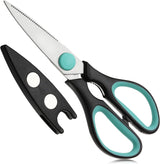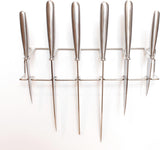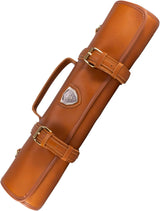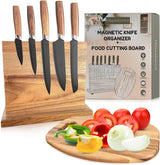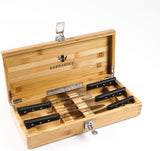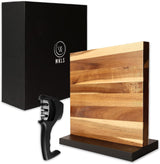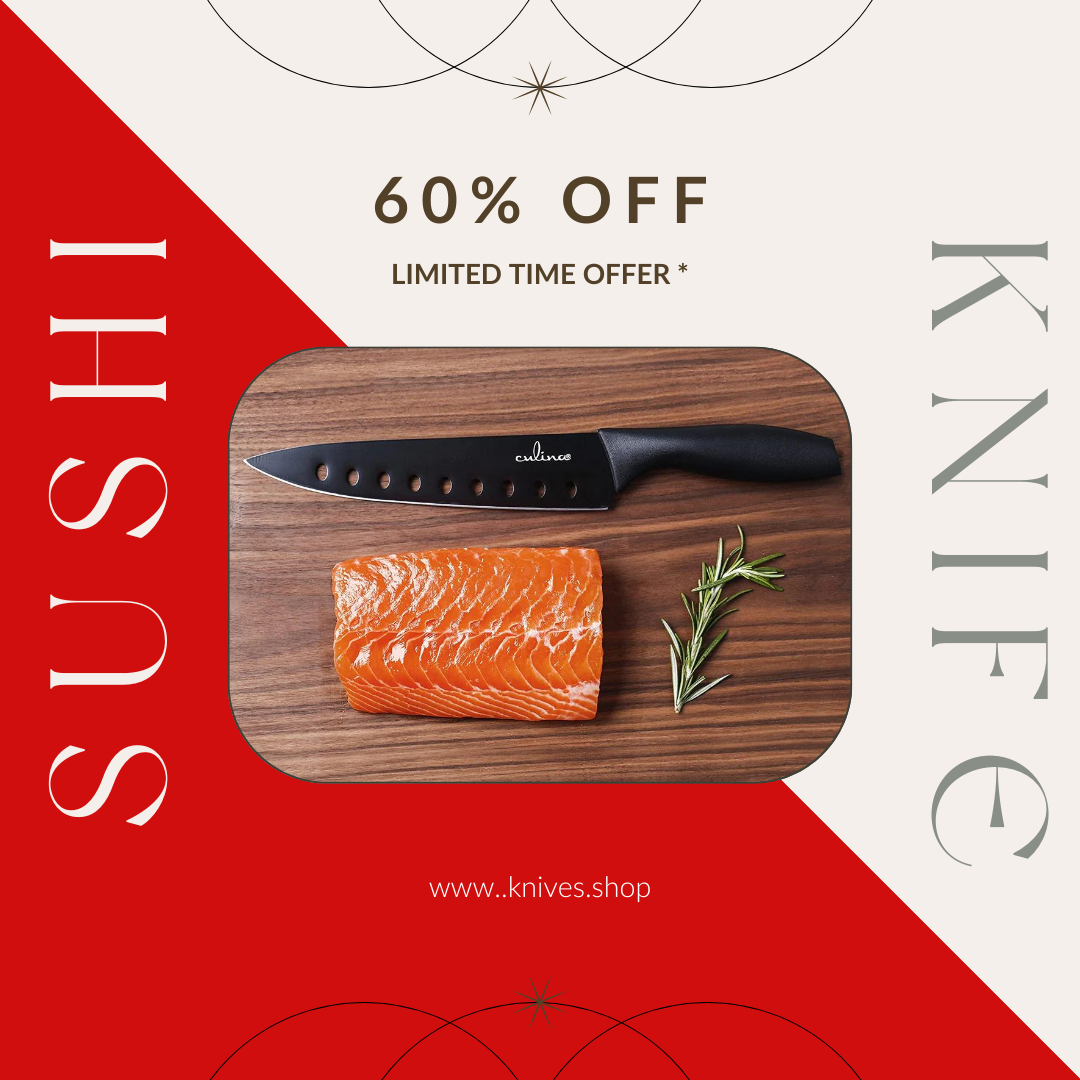Damascus steel was indeed the forged steel used in sword blades smithed in the Near East from Wootz steel ingots supplied from Southern India or produced at production centers in Sri Lanka or Khorasan, Iran. These swords have characteristic banding and mottling designs that resemble flowing water, often in a "ladder" or "roses" pattern. Blades of this type were said to be robust, shatter-resistant, and able to be honed to a sharp, durable edge.

Wootz, Pulad, Fuladh, Bulat, and Bintie are all names for historic ultra-high carbon crucible steels characterized by carbide segregation.
Damascus steel does have a wave-patterned surface that distinguishes it from other steels. Damascus steel is regarded for its toughness and flexibility while yet maintaining a razor-sharp edge, as well as its sleek appearance and appealing aesthetics.
Weapons made of Damascus steel were significantly superior to those made of iron alone.
Origin of the term Damascus steel
The origin of the term "Damascus Steel'' is debated: two Islamic authors, Al-Kindi and Al-Biruni (approximately 800-873 CE), both wrote about swords and sword steels based on appearance, the geographical place of production or forged, or the identity of the blacksmith. Both scholars mention the terms 'damscene' and 'Damascus' when discussing the sword to some extent.
Based on these sources, there are three possible origins for the word Damascus in the context of steel:
- Swords manufactured in Damascus, Siberia, were referred to as 'Damascene,' however it's worth noting that these swords were not described as having a wavy pattern on the surface of the steel.
- Al-Biruni refers to Damasqui, a swordsmith who specialized in crucible steel.
- Damascus blades are typically described as having a water pattern on their surface because the term 'damas' means 'watered' in Arabic.
The most frequent theory is that steel is named after Damascus, Syria's capital and the ancient Levant's greatest metropolis. It could be a literal reference to swords made or sold in Damascus, or it could just be a connection to Damask fabrics, which are also known as Damascus fabrics.
Cast Damascus steel
Because Damascus steel was formed from wootz, a form of steel developed over 2000 years ago in India, no one has been able to duplicate the original technique of production. The weapons and other goods fashioned from wootz were truly popular in the 3rd century as trade commodities marketed in the town of Damascus, in what is now Syria. In the 1700s, the processes for producing wootz were lost, and so was the primary source for Damascus steel. Despite extensive research and reverse engineering, no one has been able to properly create a material that is similar to cast Damascus steel.
Cast wootz steel was originally created by melting iron and steel with charcoal in a reducing (low to no oxygen) environment. The metal absorbs carbon from charcoal under these conditions. The alloy was slowly cooled, resulting in a crystalline carbide substance. Forging wootz into swords and other things produced Damascus steel. To make steel with a distinctive wavy pattern, it took tremendous ability to maintain steady temperatures.
Pattern welded Damascus steel
When you buy current "Damascus" steel, you might be getting a metal that has been engraved (surface treated) to create a light/dark pattern. Because the design can be worn away, this is not true Damascus steel.
Pattern-welded Damascus steel knives and other modern artifacts have the water pattern all the way through the metal and many of the same properties as the original Damascus metal. Layers of iron and steel are layered and smashed together at extreme temperatures to form a forged bond. The joint is sealed with flux to keep oxygen out. Although various patterns are possible, forge welding numerous layers provides the watery look distinctive of this form of Damascus steel.
Damascus steel's secret, though, isn't pattern welding. Pattern welded blades were utilized by the Celts around the sixth century BCE. So there were Vikings in the 11th century and Samurai in the 13th century. The wavy appearance of Damascus steel is only achieved through pattern welding. The steel's composition and the manner the layers are forged together are important.
What is present in Damascus steel?
Damascus steel, excluding modern stainless steel variants, has a high to ultrahigh carbon content, based on whether it was created through pattern welding or the crucible method. Crucible steel (also known as wootz or water steel) is genuine Damascus steel and has a carbon content of one to two percent, with the best versions having a carbon content of 1.5 percent. By most bladesmithing standards, that's an absurdly large sum. It also contains a number of other important components, such as vanadium, that make a contribution to its overall performance.
Pattern-welded modernism Damascus employs widely available high carbon steels, such as 15n20, which typically have a carbon content of less than 1%. These steels also rely on one-of-a-kind combinations of other elements that have been specially blended to achieve specific properties. Depending on the recipe, these steels may contain vanadium, nickel, and other trace elements.
What is the finishing process for Damascus steel blades?
Many bladesmiths will harden or anneal a billet of pattern welded Damascus steel once it has been shaped into its final form, depending on the blade's intended use. Having said that, almost all modern Damascus products are etched in acid to enhance the contrast. Pattern welded Damascus frequently requires minutes of etching time, whereas crucible steel frequently requires seconds of etching time.
How Are Damascus Knives Made?
The traditional Damascus Steel manufacturing method has evolved significantly over time. Modern Damascus steel is created by forge-welding multiple types of steel together before hammering, turning, and manipulating the metal, or by flattening and folding a single type of steel to create layers in the metal. Both of these processes produce the organic pattern found in Damascus knives.
Even though today's procedures are mostly for aesthetic purposes, the folding and refolding technique does have the virtue of leveling out any metal imperfections. More advanced procedures, like acid etching, might be employed to enhance the process's unique design.
Things to keep in mind when shopping for Damascus knives
A knife made of sturdy and resilient Damascus steel is the only one preferred by culinary experts among some of the wide range of fine dining specialist blades available.
Here are some things to consider when trying to shop for a Damascus knife for your kitchen:
Sturdiness
The most well-known feature of Damascus steel blades is their extreme toughness. More hardness meant less effort on the blade's edge, which meant it would last longer.
Execution
In the domain of blades, execution refers to how well and to what extent a steel blade can optimally cut food. That means a blade's hardness determines how good it is. Damascus steel blades keep their characteristic edge significantly longer than knives made of gentler metals. Damascus steel cutting edges usually have a thinner edge, making it easier to cut through the meat.
Financial Capacity
Damascus knives are generally more expensive than regular kitchen knives. So, expect to pay a bit more for a Damascus steel knife when shopping, but rest confident that these knives are a terrific investment for any cook, whether at home or in the kitchen.
Damascus Steel Maintenance
A Damascus steel knife that has been skillfully forged over hundreds of hours deserves to be treated with the highest respect. For optimum durability, a legacy masterpiece must be protected. Damascus steel demands extra attention to maintain its sheen and beauty.
It's important to remember that many hand-forged Damascus blades are constructed of high-carbon steel with chromium content. If not properly maintained, a blade made of such steel might rapidly corrode. Collectors must keep their blades clean to prevent rust and discoloration.
You should lubricate a Damascus steel knife with a specialist wax after cleaning it to preserve it from moisture. The pattern on the steel will remain as stunning and vibrant since the day it was hand-forged if the blade is kept away from corrosion.
Textiles and chemicals, for example, can alter the appearance of the blade. The oxidation that makes the blade's design visible can be removed using a rough cloth or metal cleaner.
The storage conditions of a blade are also very important for its longevity. When not in use, keep your Damascus steel knife in a dry interior area free of moisture and temperature fluctuations. To keep these knives, you'll need a box or a soft case.
Spotting a Fake Damascus steel blade
This is the quickest way to tell if a knife is fake Damascus. There is no way to make two knives with totally identical patterns due to the way these knives are forged and produced. If all of the kitchen knives in a set have the same pattern and features, they are not made of genuine Damascus steel.
Even if you're buying a single knife, the pattern can help you identify a fake. It's false if it's oddly formed, looks manufactured or appears unnatural, even if the pattern appears to have been made by someone. The lines between bright and dark spots in fake Damascus steel are usually quite sharp and clean, not muddled like they are in real Damascus steel.
Conclusion
Most of today's ultra unusual alloys will eventually outperform pattern-welded steel. Having and using a Damascus steel blade is more about personal taste and respect for the time and effort that went into making it.
A well-made Damascus blade will keep its sharpness for longer than most production-quality blades, but if you're looking for the greatest blade steel, look elsewhere.
If you want to acquire a high-quality Damascus steel blade, conduct your research and think of it as an investment. We have a large selection of high-quality Damascus knives.
